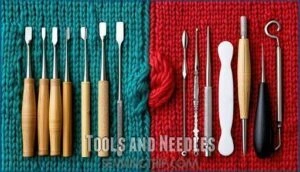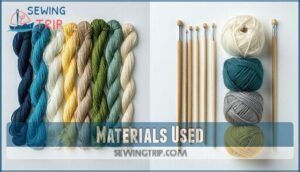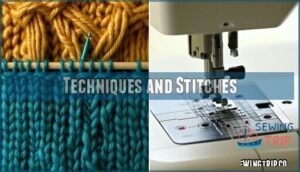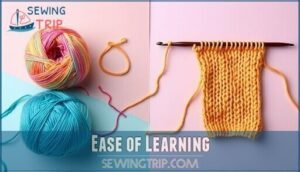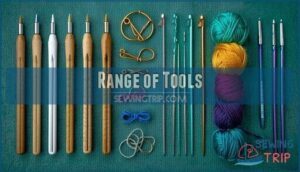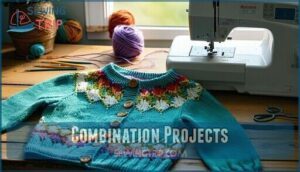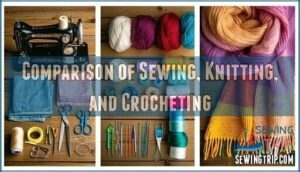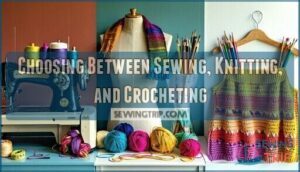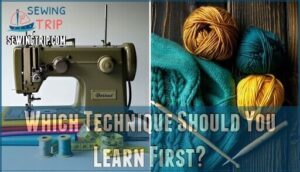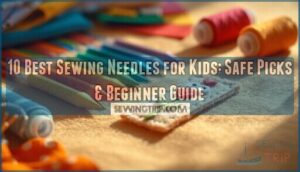This site is supported by our readers. We may earn a commission, at no cost to you, if you purchase through links.
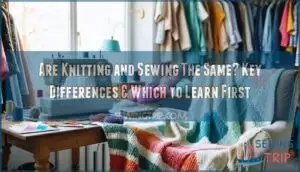
You’ll use completely different tools – knitting requires needles to create fabric from yarn through interlocking loops, while sewing joins existing fabric pieces with thread using needles or machines.
Sewing lets you craft everything from clothing to home décor with pre-made materials, offering more design flexibility.
Knitting creates stretchy, cozy items like sweaters and scarves from scratch.
Think of sewing as assembling pieces of a puzzle, while knitting builds the puzzle itself, one stitch at a time.
Each craft opens unique creative doors, but understanding their fundamental differences helps you choose the right path for your projects, allowing you to create with pre-made materials or from scratch, and make cozy items.
Table Of Contents
- Key Takeaways
- Differences Between Sewing and Knitting
- Differences Between Knitting and Crocheting
- Comparison of Sewing, Knitting, and Crocheting
- Explaining Sewing, Knitting, and Crocheting for Beginners
- Choosing Between Sewing, Knitting, and Crocheting
- Which Technique Should You Learn First?
- Which Technique Produces The Fastest Results?
- Is It Most Useful to Learn Knitting, Crocheting, or Sewing?
- Do People Typically Learn Knitting or Crocheting First?
- Frequently Asked Questions (FAQs)
- Conclusion
Key Takeaways
- You’ll use completely different tools and materials – knitting requires blunt needles and yarn to create fabric from scratch through interlocking loops, while sewing uses sharp needles and thread to join existing fabric pieces together.
- The fabric creation process is fundamentally different – when you knit, you’re building stretchy, cozy fabric one stitch at a time from continuous yarn, but when you sew, you’re assembling pre-made materials like puzzle pieces.
- Each craft offers unique creative possibilities – sewing gives you more design flexibility with patterns, textures, and garment shapes since you’re working with manufactured fabrics, while knitting specializes in creating warm, form-fitting items with built-in stretch.
- Your choice depends on your project goals and patience level – if you want quick results with custom clothing or home décor, sewing delivers faster completion, but if you enjoy meditative, repetitive work and want to create cozy wearables from scratch, knitting’s your path.
Differences Between Sewing and Knitting
While knitting and sewing might seem similar since they both use needles and create beautiful items, they’re actually quite different crafts with distinct tools and techniques.
You’ll find that knitting creates fabric from scratch using yarn and blunt needles, while sewing joins existing fabric pieces together with sharp needles and thread.
Tools and Needles
When choosing between knitting and sewing, you’ll encounter different Needle Materials and tools that define each craft’s unique character.
Each craft’s tools shape your creative journey – sharp needles for precision, blunt ones for loops, hooks for texture.
- Sewing needles are sharp, thin implements made from steel, designed to pierce fabric precisely
- Knitting needles come in various materials like bamboo, aluminum, and wood, offering different tactile experiences
- Machine Implements in sewing include specialized presser feet and bobbins for automated stitching
- Ergonomic Tools like circular knitting needles reduce hand strain during extended crafting sessions
Both crafts also use distinct methods, as sewing joins fabric while knitting employs yarn manipulation techniques.
Hook Sizes matter less in knitting than sewing, where Gauge Importance affects stitch quality.
Materials Used
Material differences between sewing and knitting start with yarn thickness and thread types.
You’ll work with fine, delicate thread for sewing—often cotton, silk, or nylon measuring less than one millimeter thick.
Knitting uses chunky yarn that’s two to five millimeters thick, made from wool, cotton, or acrylic.
Understanding different thread compositions is essential for sewing success.
This material elasticity creates different fabric variety and fiber content possibilities for your projects.
Techniques and Stitches
When you compare knitting and sewing, you’ll notice the difference in stitch complexity and fabric creation.
Knitting techniques use loops to build fabric, while sewing methods join fabric pieces with various seam types.
Here’s what sets them apart:
- Knitting: knit and purl stitches for pattern intricacy
- Sewing: running, backstitch, zigzag, and whipstitch
Error correction is easier in knitting, and sewing stitches hold, while knitting stitches build.
Design Variety
Design opens the door to endless possibilities when you sew. With sewing, you’re not limited by yarn or stitch types—there’s a world of fabric, pattern complexity, and garment shapes at your fingertips.
You can easily mix textures, adjust fit, and add details like zippers or pockets. Knitting, while creative, can’t match sewing’s sheer pattern variety and colorwork techniques.
If you want to experiment with intricate designs, sewing gives you the freedom to create almost anything you imagine. Here’s what sets sewing apart:
- Pattern complexity and variety
- Advanced colorwork techniques
- Wide texture options
- Custom garment shapes
- Endless home decor possibilities
Differences Between Knitting and Crocheting
When you compare knitting and crocheting, you’ll notice that each uses different tools and techniques to create fabric from yarn.
Understanding these differences helps you choose the best method for your projects and skill level.
Ease of Learning
Crocheting offers the gentlest learning curve for beginners since you’ll manage just one hook instead of juggling two knitting needles.
This single-tool approach makes skill acquisition faster and reduces common mistakes that trip up newcomers.
You can start with simple beginner projects like chains and basic stitches before tackling more complex stitch patterns.
Knitting demands greater hand coordination but opens doors to intricate designs.
Both crafts have abundant learning resources online, though knitting typically offers more beginner-friendly tutorials and patterns for developing your skills.
Range of Tools
After you get the hang of the basics, you’ll notice knitting offers a wider needle variety than crochet.
Knitting needles come in all shapes and sizes, while crochet hooks stick to a simpler range.
Here’s what you’ll find in your toolkit:
- Straight knitting needles
- Circular knitting needles
- Double-pointed needles
- Cable needles
- Stitch holders
Each tool supports unique textures, specialized tools, and project needs.
Combination Projects
Many knitters and crocheters enjoy mixing these fiber arts in single projects.
You might create a knitted sweater with crocheted embellishment techniques or add sewn details to knit fabric pieces.
Mixed media approaches let you combine pattern design elements from both crafts.
Tunisian crochet bridges knitting and crocheting beautifully, while sewn knitwear often features decorative crochet borders for stunning craft combination results.
Comparison of Sewing, Knitting, and Crocheting
You’ll find distinct differences when comparing these three textile crafts across their tools, techniques, and purposes.
Each method creates items differently – sewing joins existing fabrics, knitting builds fabric from yarn loops, and crocheting uses hooks to pull yarn through interconnected loops.
Creation of Fabric and Items
You’ll notice that knitting and crocheting create fabric from scratch using yarn, while sewing assembles pre-made fabrics.
These fabric arts showcase different approaches to textile creation and garment construction.
| Method | Fabric Creation | Primary Use |
|---|---|---|
| Knitting | Forms interlocking loops from continuous yarn | Sweaters, blankets, accessories |
| Crocheting | Creates fabric through single hook technique | Home decor, textiles, mixed media projects |
| Sewing | Joins existing fabric pieces with thread | Garment construction, fabric manipulation |
Knitting produces stretchy, form-fitting textiles through its unique fabric structure.
Crocheting offers versatility for textile art and fiber projects.
Sewing transforms manufactured materials into finished garments and home decor items through precise fabric manipulation techniques.
The knitting process often begins with careful yarn selection to achieve the desired fabric properties.
Tools and Techniques
When you hold your tools, each craft demands different techniques.
Sewing needles pierce fabric with precision, while knitting needles loop yarn through existing stitches.
Crocheting hooks pull new loops through previous ones, creating unique textures.
| Craft | Primary Tool | Technique |
|---|---|---|
| Sewing | Sharp needle | Pierces and joins fabric pieces |
| Knitting | Blunt needles | Loops yarn through active stitches |
| Crocheting | Single hook | Pulls yarn through completed loops |
Machine usage varies substantially between crafts.
Sewing machines accelerate fabric joining, while knitting machines automate stitch creation.
Pattern design complexity ranges from simple running stitches in sewing to intricate cable patterns in knitting, each requiring specific needle variations and techniques.
Types of Stitches
Each craft uses distinct stitches that serve specific functions.
Understanding these differences helps you choose the right technique for your project goals.
| Craft | Basic Stitches | Complexity | Function |
|---|---|---|---|
| Knitting | Knit vs Purl combinations | Medium | Creates fabric structure |
| Sewing | Seam Stitches (straight, zigzag) | High | Joins existing fabrics |
| Crochet | Crochet Stitches (single, double) | Low | Builds loops into fabric |
| All Three | Foundation techniques | Varies | Provides project structure |
Knitting techniques revolve around the knit stitch and purl stitch to create textures.
Sewing techniques focus on seam stitches for precision joining.
Stitch complexity varies substantially—crochet offers simpler loops while sewing demands technical accuracy for durability.
Versatility and Tasks
Each craft offers unique versatility in creation.
Sewing excels at Garment Creation and Home Decor projects, from custom clothing to curtains.
Knitting specializes in cozy wearables like sweaters and accessories.
Crocheting shines in Textile Art pieces and decorative items.
All three techniques provide excellent Repair Options for extending item lifespans.
These skills complement each other beautifully in Mixed Media projects, where combining techniques creates innovative designs.
| Craft | Primary Strengths | Common Projects |
|---|---|---|
| Sewing | Garment Creation, Home Decor | Clothing, bags, curtains |
| Knitting | Wearable comfort items | Sweaters, scarves, socks |
| Crocheting | Decorative Textile Art | Blankets, doilies, amigurumi |
Explaining Sewing, Knitting, and Crocheting for Beginners
If you’re new to crafting, understanding the basics of each technique will help you choose where to start your creative journey.
Let’s break down what makes sewing, knitting, and crocheting unique so you can pick the perfect fit for your interests and goals.
Sewing Basics
Getting started with sewing requires basic supplies: sewing needles, thread, scissors, fabric, and sewing patterns.
Begin by threading your needle and securing the thread with a knot.
Practice fundamental hand stitches like running stitch and backstitch, maintaining consistent tension throughout.
Understanding fabric types helps you choose appropriate materials for your project.
Pattern reading skills develop as you follow instructions step-by-step.
Master basic seam finishes to create professional-looking results.
Once comfortable with hand sewing, move to a sewing machine for faster project completion.
To confirm you have everything needed, consider purchasing essential sewing kits.
Regular machine maintenance guarantees smooth operation.
Building these sewing skills takes patience and practice.
Knitting Basics
Learning knitting begins with understanding yarn types and needle sizes for your project.
Start by casting on stitches, then master basic knit and purl techniques.
These fundamental stitches create every knitting pattern.
Practice maintaining even tension while working rows.
Reading simple patterns helps beginners progress from scarves to complex designs.
Knitting transforms single yarn strands into beautiful, wearable fabric through repetitive, meditative motions, creating something from single yarn strands.
Crocheting Basics
If you’ve just explored knitting, crocheting basics offer a fresh twist.
With just a hook and yarn, you’ll create everything from hats to blankets—no fancy machines needed.
Start by picking the right hook size and yarn type for your project ideas.
Learn the chain stitch, then move to single crochet, half-double, and double crochet.
Focus on stitch anatomy and practice pattern reading as you go.
Crocheting lets you work at your own pace, building skills and confidence with every row.
Choosing Between Sewing, Knitting, and Crocheting
When you’re deciding between sewing, knitting, and crocheting, it helps to take into account your goals, skill level, and how quickly you want to see results.
Each technique uses different tools and materials, so your choice depends on what you want to make and how you prefer to work, considering your skill level.
Preferences and Goals
Understanding your preferences and goals helps you choose the right craft for your journey.
Consider what draws you most strongly to creative work.
- Project goals – Do you want to create clothing, home decor, or accessories?
- Personal style – Are you drawn to structured precision or flowing creativity?
- Creative outlet – Do you prefer working with fabric pieces or building from yarn?
- Relaxation method – Does repetitive motion or detailed construction calm you more?
- Skill development – Are you seeking quick wins or long-term mastery?
Your motivations matter.
Sewing offers precise construction and garment fitting.
Knitting provides meditative rhythm and cozy textures.
Each craft rewards different temperaments and interests, so choose what speaks to you.
Skill Level and Learning Curve
When weighing your options, consider each craft’s learning curve carefully.
Sewing demands pattern reading and machine operation skills, typically requiring 20-30 hours for garment construction proficiency.
Knitting focuses on repetitive stitches and muscle memory, achieving wearable results in 15-25 hours.
Crocheting offers the gentlest introduction for beginners.
| Craft | Beginner Projects | Error Correction |
|---|---|---|
| Sewing | Simple hems, pillowcases | Seam ripping risks fabric damage |
| Knitting | Scarves, dishcloths | Easy unknitting without material loss |
| Crocheting | Granny squares, beanies | Simple unraveling to fix mistakes |
| Learning Resources | Abundant online tutorials | Varies by complexity level |
| Mastering Techniques | Patience required for all | Skills build progressively |
Speed of Project Completion
Project completion speed varies dramatically across crafts.
Crocheting typically wins the race, followed by sewing, then knitting.
Your tool proficiency and pattern intricacy directly impact time investment.
Speed comparison factors:
- Stitch density – Crocheting creates fabric faster than knitting’s tighter stitches
- Material choice – Chunky yarns work up quicker than fine threads
- Project complexity – Simple scarves beat intricate sweaters every time
Which Technique Should You Learn First?
Before diving into your first fiber art, consider what draws you to crafting. Your Project Goals matter most when choosing where to start. Want cozy sweaters and blankets? Knitting teaches essential yarn skills perfect for winter wear. Dream of custom clothing, bags, or quilts? Sewing builds your fabric foundation first.
Personal Interest drives success more than difficulty level. While crocheting offers quicker results, don’t let that alone guide your choice. Match your Learning Style with the craft’s demands – sewing requires precision and technical thinking, while knitting uses repetitive, meditative motions.
Here’s a quick comparison to help decide:
| Aspect | Sewing | Knitting | Crocheting |
|---|---|---|---|
| Skillset Match | Detail-oriented, precise | Patient, rhythmic | Quick, forgiving |
| Time Commitment | High setup/learning | Moderate practice | Low initial effort |
| Beginner Results | Complex projects | Simple scarves | Fast accessories |
| Techniques Variety | Many stitch types | Basic knit/purl | Versatile hooks |
| Learning Curve | Steep but rewarding | Steady progression | Gentle start |
Choose what sparks passion – that enthusiasm will carry you through beginner challenges toward mastery. To begin, you’ll need to gather the essential sewing tools to prepare for your first project.
Which Technique Produces The Fastest Results?
Machine sewing delivers the fastest results when you’re looking for speed. You’ll complete simple shirts in just 1-3 hours, while automated machines can finish them in 15-25 minutes. That’s lightning fast compared to knitting or crocheting the same garment.
Crocheting takes second place for speed. You can whip up a basic hat in 1-2 hours, and those chunky stitches cover ground quickly. Knitting comes in last – that cozy sweater you’re planning? Expect 15-40 hours of work, even with speedy techniques.
Here’s what affects your speed across all three techniques:
- Material thickness – Chunky yarns and heavy fabrics work up faster than delicate threads
- Pattern simplicity – Basic designs beat intricate cables or complex seaming every time
- Tool proficiency – Your skill with machines, hooks, or needles makes a huge difference
- Stitch density – Loose, open stitches finish faster than tight, dense fabric
Project complexity matters too. While sewing excels at quick construction, knitting and crocheting shine when you want handmade texture that machines can’t replicate. To improve hand sewing speed, remember to practice consistent stitch length.
Is It Most Useful to Learn Knitting, Crocheting, or Sewing?
In terms of usefulness, the answer depends on your Project Goals, Skill Investment, and Personal Preference.
Knitting, sewing, and crocheting each have their own Practical Applications.
If you’re interested in repairing clothes or making home items, sewing might be the most practical.
Knitting and crocheting, on the other hand, let you create cozy scarves, hats, and blankets from scratch—perfect if you want to make custom gifts or stylish wearables.
Think about Cost Analysis too.
Sewing often requires more tools—fabric, thread, needles, and sometimes a machine—while knitting and crocheting usually just need yarn and needles or a hook.
Each skill takes time to master, but you’ll find that dedication pays off, no matter which you choose.
Regular practice can also provide significant stress relief.
Try a simple project in each area to see what sparks your interest.
Your skills will grow with practice, and you’ll discover which craft fits your creative vision.
Do People Typically Learn Knitting or Crocheting First?
Most beginners gravitate toward crocheting before knitting. Crochet’s ease makes it the natural starting point for newcomers to fiber crafts. You’ll only manage one hook instead of juggling two needles, which simplifies the learning process substantially.
Crocheting gives beginners an instant confidence boost with just one hook to master.
The learning curve for crocheting feels gentler. Mistakes are easier to spot and fix since you’re working with one active stitch at a time. You can see your progress immediately, which keeps motivation high during those first few projects.
Knitting popularity means more patterns exist online, but that abundance can overwhelm beginners. Crocheting offers fewer but more manageable options for starter projects like dishcloths or simple scarves.
Resource availability varies between crafts. While knitting tutorials flood the internet, crochet’s straightforward techniques require less explanation. Most people find they can pick up basic crochet skills through trial and error.
Beginner projects in crochet work up faster, giving you that satisfying sense of accomplishment. Your hands adapt to the rhythm quickly, building confidence for more complex skills later.
Frequently Asked Questions (FAQs)
What is the difference between knitting & sewing?
Like threading two different tapestries, knitting and sewing follow distinct paths.
You’ll create fabric from yarn using two needles with knitting, while sewing joins existing fabrics together using sharp needles and thread.
What is the difference between sewing thread and knitting yarn?
Sewing thread is thin (under 1mm), delicate, and lightweight, made from cotton, silk, or nylon.
You’ll find knitting yarn much thicker (2-5mm), softer, and made from wool, cotton, or acrylic for creating fabric structure, with complete concepts like these being key to understanding the differences.
Is knitting the same as knitting?
Yes, knitting is exactly the same as knitting! You’re asking about one identical craft. Knitting involves using two needles to create fabric from yarn through interlocking loops.
What is the difference between sewing and knitting utensils?
Imagine your tools as teammates—knitting uses two thick, blunt needles to weave yarn, while you’ll grab a sharp, slender sewing needle to stitch fabric with thread.
Each utensil’s shape and size fit its unique purpose.
What is the difference between sewing stitches and knitting stitches?
Sewing stitches join separate fabric pieces together, while knitting stitches create the actual fabric from yarn. You’re combining materials versus building them from scratch using different techniques.
Is knitting easier than sewing?
You’ll find knitting easier to pick up, especially as a beginner, since you only manage two needles and yarn.
Sewing demands more technical skill, pattern reading, and machine handling, so it’s got a steeper learning curve.
Is knitting the same as sewing?
No, they’re different crafts. You’ll use thick yarn and two needles to create fabric when knitting, while sewing joins pre-made fabric pieces with thread and sharp needles.
What is the downside of knitting?
Knitting’s downsides include time-intensive projects, dropped stitches requiring rework, hand strain from repetitive motions, expensive yarn costs, and steep learning curves for complex patterns requiring patience.
Why are knits hard to sew?
Wrestling with knit fabric is like trying to tame a stretchy snake—it won’t stay put!
Knits stretch and distort easily, making seams wavy.
You’ll need stretch stitches, ballpoint needles, and proper stabilizing techniques to prevent puckering.
Is crocheting basically knitting?
No, crocheting isn’t basically knitting.
You’ll use one hook for crocheting versus two needles for knitting.
Crocheting creates different stitch structures and is typically easier for beginners to learn than coordinating dual needles, making it a more accessible hobby.
Conclusion
Despite thinking you’ll master all three crafts simultaneously, focusing on one technique first builds stronger foundational skills.
Whether you’re wondering "are knitting and sewing the same," the answer remains clear: they’re distinct crafts requiring different approaches.
Sewing offers immediate gratification with pre-made fabrics, while knitting creates cozy items from scratch.
Choose based on your project goals and patience level.
Each craft rewards dedication with unique creative possibilities, from custom garments to handmade gifts that showcase your personal style.
- https://sewing.com/choosing-sewing-needles/
- https://www.thesprucecrafts.com/types-of-knitting-needles-2117219
- https://blog.treasurie.com/sewing-thread-types/
- https://nimble-needles.com/wool-and-tools/the-best-knitting-tools-and-materials/
- https://www.moodfabrics.com/blog/the-ultimate-list-of-sewing-supplies/

